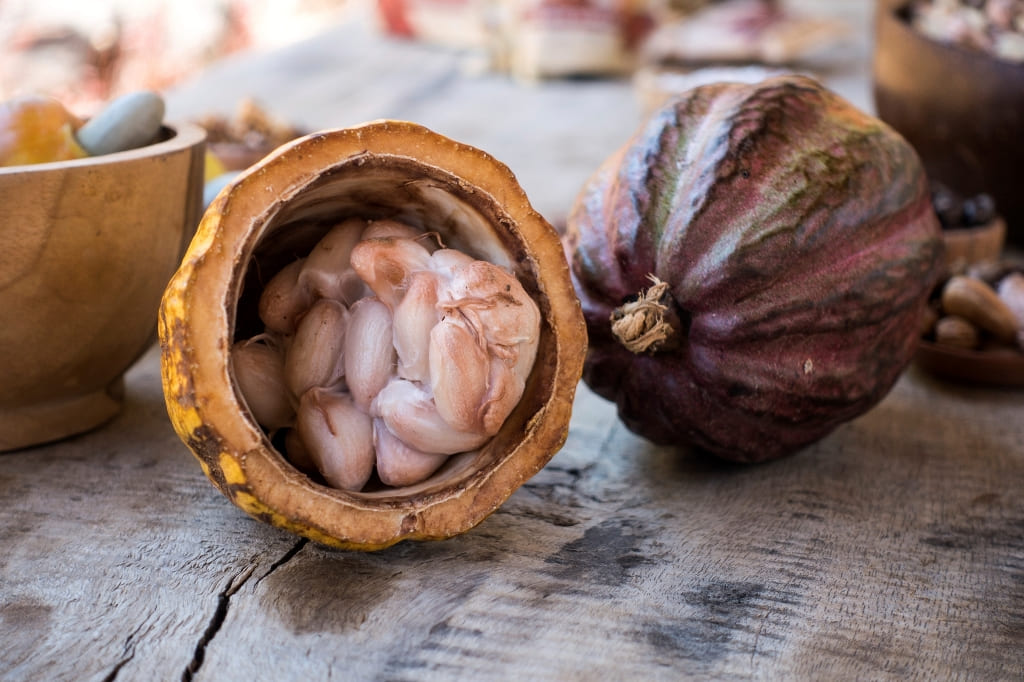What is Cocoa Mass? | Cocoa mass meaning | What is cocoa mass in chocolate?
Cocoa Mass, otherwise known as cocoa liquor, is a key part of chocolate. As the main constituent of many chocolate products, it has an effective influence on the flavor of chocolate; its texture and quality as well. As such, aiming to analyze cocoa mass, its definition, the production procedure, its composition, uses and nutrition elements, it is essential to understand its significance in the world of chocolate.

Composition of Cocoa mass
In terms of structure, cocoa mass is composed of two components that are formed in almost equal amounts: cocoa solids and cocoa butter.
- Cocoa Solids: This is the prime factor that contributes to the color and the appearance of chocolate. Chocolate also includes various components dissolved in these solids that are responsible for its profound and exquisite flavor.
- Cocoa Butter: This natural fat allows chocolate to have a smooth texture, as well as a silky consistency when melted in the mouth. It also has significant importance when it comes to tempering chocolate.
The quality and flavor conciliation of cocoa mass is however dependent on a number of variables such as the region where the cocoa beans were grown, the order in which the fermentation and roasting, as well as grinding, took place
How Cocoa mass is produced?
Cocoa mass is generally a paste prepared from grinded cocoa beans having thick consistency. The paste essentially has cocoa solid and cocoa butter content, which are the two components that make it possible to produce a larger amount of chocolate having great flavor and texture. Cocoa mass, contrary to its name, is actually non-alcoholic; it is referred to ‘liquor’, because it is in liquid-like form when heated. The terms chocolate liquor, cocoa liquor, and cocoa mass, are vernacular terms used interchangeably in the chocolate industry.
How to make cocoa mass: Production process of Cocoa mass
Mastering from Cocoa beans to cocoa mass can be achieved through key stages that include:
- Harvesting: The procedure begins with the cutting of cacao trees and getting cocoa pods. The machete is the most commonly used tool on this juncture where the pods are sliced in order to obtain the cocoa beans.
- Fermentation: Once the beans are taken out, these beans undergo another rigorous process of fermentation which compacts a lot of the chocolate flavours into one. The beans are kept in heaps shown as fermentation boxes that have banana leaves across the surface for 3 to 7 days. While the beans sit there, the enzymes placed attack the pulp abounding the beans and the microbes residing the beans start producing heat which is one of the essential components for flavours. Such processes mitigate the bitterness of the beans while also augmenting its aroma.
- Drying: Once fermentation is finished, the beans are laid out for sun drying or in a hot dryer. This particular step dry out any moisture whilst augmenting the stability of flavor and aroma of the beans.
- Cleaning and Sorting: Foreign materials such as twigs, stones, and other materials that were collected by be beans are cleaned once dried. The beans are then sorted by their size and quality before shredding to ensure uniformity.
- Roasting: In controlled temperatures, the beans that were cleaned are roasted. This is crucial as complex flavors and scent are created as well as loosening the shells from the nibs which is the edible part of the cacao bean. Depending on the preferred taste variety, degree of roast also differs from one another.
- Cracking and Winnowing: Once the beans are roasted, they are winnowed in order to free the cocoa nibs from the outer shells. It uses air currents to remove the lightweight shell pieces while leaving behind only the nibs.
- Grinding: A paste known as cocoa mass, also known as cocoa liquor, is formed after the nibs are pressed. Its because of the Nibs being 50-57% fat when pressed causes it to separate and make a thick paste consisting of cocoa solids and cocoa butter.

Image Credit: thealembicslab.com
Cocoa mass, after its creation, can be used directly for the making of chocolate or it can be processed further by separating into cocoa powder and cocoa butter. The mass cocoa is produced through an elaborate procedure that involves changing dirty raw cocoa beans into mass cocoa that is useful in the making of chocolates. Since cocoa mass is so critical to the manufacture of fine grade chocolate products, each stage of processes such as fermentation or grinding which has a bearing on the end flavor and quality of cocoa mass should be regarded as crucial steps.
The role of Cocoa mass in chocolate making
Cocoa mass constitutes an important ingredient in making a variety of chocolate products; dark chocolate, milk chocolate and even white chocolate, though the latter contains predominantly cocoa butter. Here’s how it contributes to different types of chocolate:
- Dark Chocolate: Sugar is sometimes added to cocoa mass but it’s the cocoa mass that is the most dominant ingredient along with sugar and sometimes additional cocoa butter. The addition and proportion of cocoa mass will determine the strength of chocolate flavor in that bar.
- Milk Chocolate: Milk powder and sugar are the main ingredients along with cocoa mass. Condensed milk can be used as a substitute to give creaminess in taste. The ratio of these items will determine the sweetness and flavor.
- White Chocolate: White chocolate is not considered ‘chocolate’ as it does not contain any cocoa solids. White chocolate however, consists of cocoa butter, sugar, and milk.
Chocolatiers are able to mix proportions of several different substances alongside cocoa mass, any combination and creation can result in a plethora of new flavors for consumers.
Cocoa mass benefits: Nutritional benefits of Cocoa mass
More than just a tasty ingredient, cocoa liquor has various health and nutritional benefits:
- Rich in Antioxidants: Cocoa mass contains flavonoids that are known for their antioxidant properties. These compounds can help combat oxidative stress in the body.
- Heart Health: There are studies and evidence that suggest in the regular use of cocoa products, cardiovascular health is enhanced. Flavinoids present in cocoa may also aid in hypertension management, enhanced blood flow and improved heart health by aiding in endothelial functions.
- Mineral Content: Cocoa mass contains essential nutrients such as magnesium, iron, copper and manganese that the body requires.
- Mood Enhancement: Consuming products made with cocoa mass (cocoa liquor) is known to boost the production of endorphins, which may help enhance a person’s mood.
While it is important to understand that cocoa liquors are known to elevate health, users must be careful of the moderation due to nutritional caloric content.
Differences between Cocoa mass and other Cocoa products
It is important as a consumer and manufacturer to know how cocoa liquor differs from other products:
Cocoa Powder vs. Cocoa Butter
- Cocoa Powder: This product is derived from cocoa mass after most of the cocoa butter has been extracted through pressing. As a result, it contains primarily non-fat cocoa solids with little to no fat content.
- Cocoa Butter: The fat obtained from the cocoa bean during its processing is known as cocoa butter, although it adds smoothness it does not provide much taste and that rich flavor that the cocoa solids have.

Summary Table
| Feature | Cocoa Mass | Cocoa Powder | Cocoa Butter |
|---|---|---|---|
| Composition | Equal parts solids & fat | Primarily solids | Pure fat |
| Flavor | Rich & intense | Chocolate-flavored | Neutral |
| Uses | Base for all chocolates | Baking & flavoring | Confectionery & cosmetics |
Cocoa mass, also known as cocoa liquor, is a vital ingredient in chocolate production and offers a range of nutritional benefits. This article provides detailed nutritional information about cocoa mass, highlighting its composition, health benefits, and potential dietary considerations.
Cocoa mass nutritional information | Nutritional composition of Cocoa mass
A combination of cocoa solids and cocoa butter can be found in cocoa mass and thus, it has certain nutritional content. Presented in the subsequent table are standard nutritional values per 100 grams weight of cocoa mass:
| Nutrient | Amount per 100g |
|---|---|
| Calories | 598 – 650 kcal |
| Total Fat | 52 – 54 g |
| – Saturated Fat | 30 – 33 g |
| – Monounsaturated Fat | 18 – 19 g |
| – Polyunsaturated Fat | 2 – 3 g |
| Cholesterol | 0 mg |
| Sodium | 2 – 5 mg |
| Total Carbohydrates | 15 – 27 g |
| – Dietary Fiber | 14 – 15 g |
| – Sugars | 0.5 – 2 g |
| Protein | 11 – 14 g |
| Calcium | 80 mg |
| Iron | 15 mg |
Breakdown of Nutritional Components
- Calories: The majority of the calories found in cocoa mass comes from fats. Typically the calorie range per 100 grams of cocoa mass ranges from 598-650 calories, putting it in the high calorie food group.
- Fat Content:
- On average, cocoa mass contains about 52% to 54% of fat from cocoa butter.
- The fat profile includes:
- Saturated Fat: About 30% to 33% stearic acid and palmitic acid.
- Monounsaturated Fat: Approximately 18% to 19% oleic acid.
- Polyunsaturated Fat: Between 2% to 3%
- Carbohydrates: On average cocoa mass contains between 15g and 27g of carbohydrates mainly from dietary fibers.
- Dietary Fiber: Comes in between 14g to 15g as well contains beneficial nutrients perfect for enhancing digestion and controls appetite.
- Sugars: Roughly 0.5g to 2g per serving as cocoa liquor is unsweetened.
- Protein: on average most cocoa liquors contain between 11g – 14g of protein, hence are ideal for protein intake from plants.
- Vitamins and Minerals:
- Rich in essential minerals such as:
- Calcium (80 mg): Important for bone health.
- Iron (15 mg): Essential for oxygen transport in the blood.
- Contains trace amounts of other minerals like magnesium, potassium, and zinc.
- Rich in essential minerals such as:
Dietary Considerations
While cocoa mass has numerous health benefits, there are some considerations:
- Caloric Density: This is a high calorie product, and thus, will need to be consumed in moderation for those on a strict calorie diet.
- Fat Content: Sufferers of high cholesterol may not be greatly affected by cocoa butter since its primary fats are healthy; however, portion control should still be strict particularly for individuals on a low-fat diet.
- Allergens: Cocoa mass may be processed alongside milk and nuts, hence sufferers of allergies ought to be concerned and read labels carefully.
Cocoa mass, its unique composition—high in healthy fats, fiber, and antioxidants—makes it a valuable addition to a balanced diet when consumed mindfully. Understanding its nutritional profile can help consumers make informed choices about incorporating cocoa mass into their diets for both enjoyment and health benefits.
Cocoa Mass is Veg: What you need to know about its ingredients
Cocoa mass may be seen as safe for both vegetarian and vegan diets as it originates from cocoa beans and are plant-derived sources. It is composed of the cocoa butter and cocoa solids which are obtained from cocoa beans through fermentation, drying, roasting, and grinding processes.
Cocoa mass however does not have animal products incorporated, however it is advisable not add other ingredients into cooked finished chocolate products as these can contain non-vegan ingredients like milk that are not suitable for vegans. Pure cocoa mass is however an appropriate ingredient for someone a follower of a vegan diet.
Cocoa mass ingredients
This compound consists of two components derived from cocoa beans — cocoa solids and cocoa butter. The composition of this compound can be seen below in a brief outline:
Major Ingredients of Cocoa Mass
1. Cocoa Solids:
- These are the non fat fractions of cocoa beans and these are responsible for the flavour and color of the chocolate.
- A variety of beneficial elements can be found in cocoa solids, including:
- Theobromine: This is a substance that reduces the bitter taste and improves mood.
- Polyphenols: These are natural substances present in plants that have antioxidant properties that help in inflammation reduction while aiding in heart disease prevention.
- Minerals: These include copper, potassium, zinc, iron as well as magnesium all of which are important for the body.
2. Cocoa Butter:
- This is the fat extracted from cocoa beans and accounts for 55-50% of the total cocoa mass.
- Cocoa butter works to provide chocolate with a smooth and creamy texture.
- Packed within it are diverse molecules of fatty acids including:
- Oleic acid: This is a fat type that falls under the monounsaturated category and is favorable for the heart.
- Stearic acid: This saturated type of fat has no impact on cholesterol levels.
- Palmitic Acid: This also saturated type of fat present in small quantities.
Nutritional Overview
The caloric value of cocoa mass is high, containing about 600 kcal per 100 g, with its composition generally comprising mass percentages of:
- Fat: 50-55 %
- Proteins: 12-16 %
- Carbohydrates: 15-27 %, of which approximately 16 % is fiber.
- Water content is also low (< 3 %)
Technically, cocoa mass is simply the most natural form of chocolate that can be used as base for most of the chocolate products. With its complex nutrient composition, the cocoa mass is equally important in both food and pharmaceutical industries.
Must Read,
✔️ Karpooravalli: Everything You Wanted to Know
✔️ Is it Safe to Eat Apple with Tea or Coffee?
Conclusion
Cocoa mass is crucial in chocolate manufacture, because it serves as the taste and structural component needed for good chocolate products. It is the only ingredient that contains both sources of fat and can be used in making chocolate for different ages. Importantly, increasing awareness of the role of this ingredient is more than just valuing cocoa products, but understanding the nutritional value of the treat as well.
Cocoa mass is a relevant ingredient that will take up more space on the conscious of the average public, educated about what is in their food products, and as a consequence, will let the average consumer understand and make wise and healthy dietary choices, while allowing themselves one of the most delicious inventions out there, chocolate.









